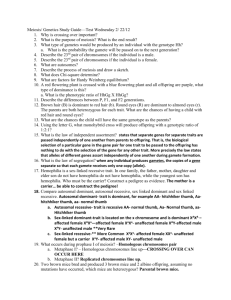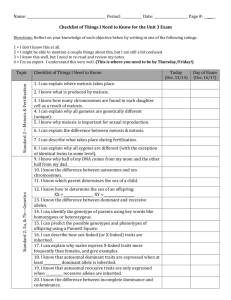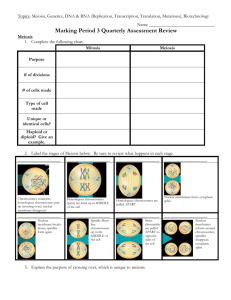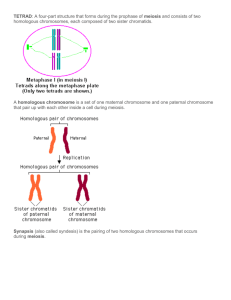Review #4 – Chapters 13 – 15
advertisement
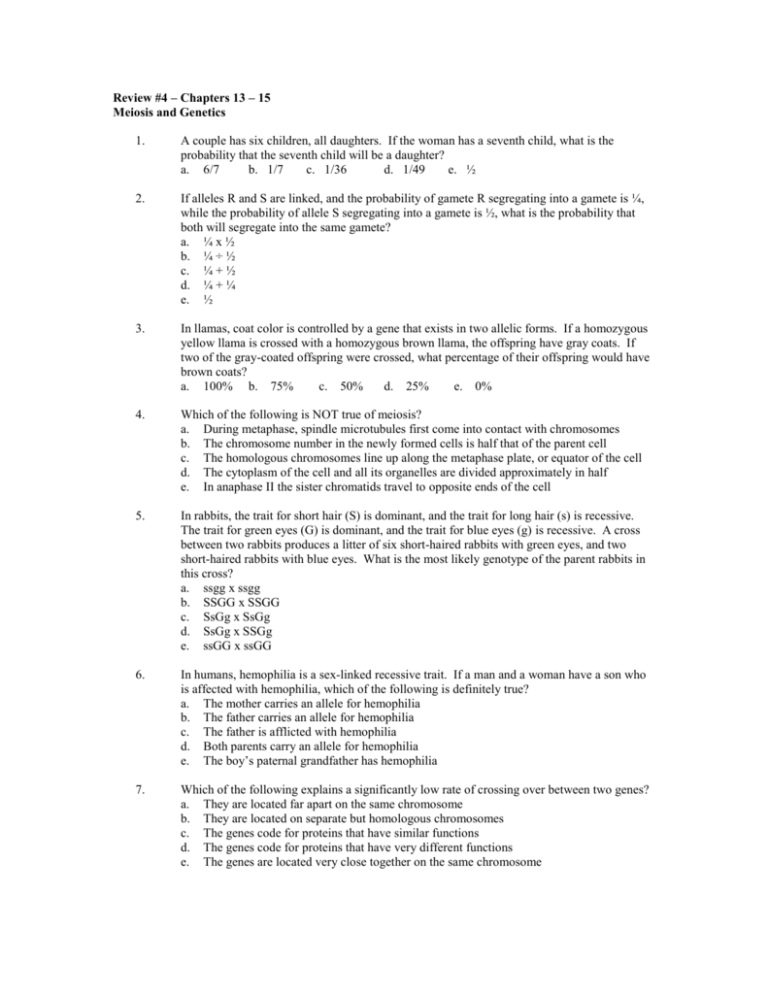
Review #4 – Chapters 13 – 15 Meiosis and Genetics 1. A couple has six children, all daughters. If the woman has a seventh child, what is the probability that the seventh child will be a daughter? a. 6/7 b. 1/7 c. 1/36 d. 1/49 e. ½ 2. If alleles R and S are linked, and the probability of gamete R segregating into a gamete is ¼, while the probability of allele S segregating into a gamete is ½, what is the probability that both will segregate into the same gamete? a. ¼ x ½ b. ¼ ÷ ½ c. ¼ + ½ d. ¼ + ¼ e. ½ 3. In llamas, coat color is controlled by a gene that exists in two allelic forms. If a homozygous yellow llama is crossed with a homozygous brown llama, the offspring have gray coats. If two of the gray-coated offspring were crossed, what percentage of their offspring would have brown coats? a. 100% b. 75% c. 50% d. 25% e. 0% 4. Which of the following is NOT true of meiosis? a. During metaphase, spindle microtubules first come into contact with chromosomes b. The chromosome number in the newly formed cells is half that of the parent cell c. The homologous chromosomes line up along the metaphase plate, or equator of the cell d. The cytoplasm of the cell and all its organelles are divided approximately in half e. In anaphase II the sister chromatids travel to opposite ends of the cell 5. In rabbits, the trait for short hair (S) is dominant, and the trait for long hair (s) is recessive. The trait for green eyes (G) is dominant, and the trait for blue eyes (g) is recessive. A cross between two rabbits produces a litter of six short-haired rabbits with green eyes, and two short-haired rabbits with blue eyes. What is the most likely genotype of the parent rabbits in this cross? a. ssgg x ssgg b. SSGG x SSGG c. SsGg x SsGg d. SsGg x SSGg e. ssGG x ssGG 6. In humans, hemophilia is a sex-linked recessive trait. If a man and a woman have a son who is affected with hemophilia, which of the following is definitely true? a. The mother carries an allele for hemophilia b. The father carries an allele for hemophilia c. The father is afflicted with hemophilia d. Both parents carry an allele for hemophilia e. The boy’s paternal grandfather has hemophilia 7. Which of the following explains a significantly low rate of crossing over between two genes? a. They are located far apart on the same chromosome b. They are located on separate but homologous chromosomes c. The genes code for proteins that have similar functions d. The genes code for proteins that have very different functions e. The genes are located very close together on the same chromosome 8. In the pedigree above, circles represent females and squares represent males; those who express a particular trait are shaded, whereas those who do not are not shaded. Which pattern of inheritance best describes the pedigree for this trait? a. Sex-linked recessive b. Sex-linked dominant c. Autosomal recessive d. Autosomal dominant e. Codominant Questions 9 – 10 refer to an individual with blood type O, whose mother has blood type A. 9. The father must have which of the following blood types? a. A, B, or O b. AB or A c. AB or B d. AB only e. O only 10. If the type O individual were to mate with a person with type AB blood, which of the following is the best calculation of the ratio of the offspring? a. 3 IAi:1 IBi b. 2 IAi:1 IBi c. IAi:IBi d. 1 IA: 2 IAIB:1 IBi e. 9 IAIB:3 IAi:3 IBi: 1 O 11. Two yellow mice with the genotype Yy are mated. After many offspring, 2/3 are yellow and 1/3 are not yellow (a 2:1 ratio). Mendelian genetics dictates that this cross should produce offspring that were ¼ YY (yellow), ½ Yy (yellow) , and ¼ yy (not yellow). What is the most likely conclusion from this experiment? a. The mice did not bear enough offspring for the ratio calculation to be specific b. Y is lethal in the homozygous form and caused death early indevelopment c. Nondisjunctin occurred d. A mutation masked the effects of the Y allele e. A mutation masked the effects of the y allele 12. All of the following contribute to genetic recombination EXCEPT a. Random fertilization b. Independent assortment c. Crossing over d. Gene linkage e. Random gene mutation 13. In cucumbers, warty (W) is dominant over dull (w), and green (G) is dominant over orange (g). A cucumber plant that is homozygous for warty and green is crossed with one that is homozygous for dull and orange. The F1 generation is then crossed. If a total of 144 offspring is produced in the F2 generation, which of the following is the closest to the number of dull green cucumbers expected? a. 3 b. 10 c. 28 d. 80 e. 111 14. The restoration of the diploid chromosome number after halving in meiosis is due to a. Synapsis b. Fertilization c. Mitosis d. DNA replication e. Chiasmata 15. During the first meiotic division (meiosis I), a. Homologous chromosomes separate b. The chromosome number becomes haploid c. Crossing over between nonsister chromatids occurs d. Paternal and maternal chromosomes assort randomly e. All of the above occur 16. A cell with a diploid number of 6 could produce gametes with how many different combinations of maternal and paternal chromosomes? a. 6 b. 8 c. 12 d. 64 e. 128 17. The DNA content of a diploid cell is measured in the G1 phase. After meiosis I, the DNA content of one of the two cells produced would be a. Equal to that of the G1 cell b. Twice that of the G1 cell c. One-half that of the G1 cell d. One-fourth that of the G1 cell e. Impossible to estimate due to independent assortment of homologous chromosomes 18. A synaptonemal complex would be found during a. Prophase I of meiosis b. Fertilization or syngamy of gametes c. Metaphase II ofmeiosis d. Prophase of mitosis e. Anaphase I of meiosis 19. Meiosis II is similar to mitosis because a. Sister chromatids separate b. Homologous chromosomes separate c. DNA replication precedes the division d. They both take the same amount of time e. Haploid cells are produced 20. Which of the following is NOT true of homologous chromosomes? a. They behave independently in mitosis b. They synapse during the S phase of meiosis c. They travel together to the metaphase plate in prometaphase of meiosis I d. Each parent contributes one set of homologous chromosomes to an offspring e. Crossing over between nonsister chromatids of homologous chromosomes is indicated by the presence of chiasmata

